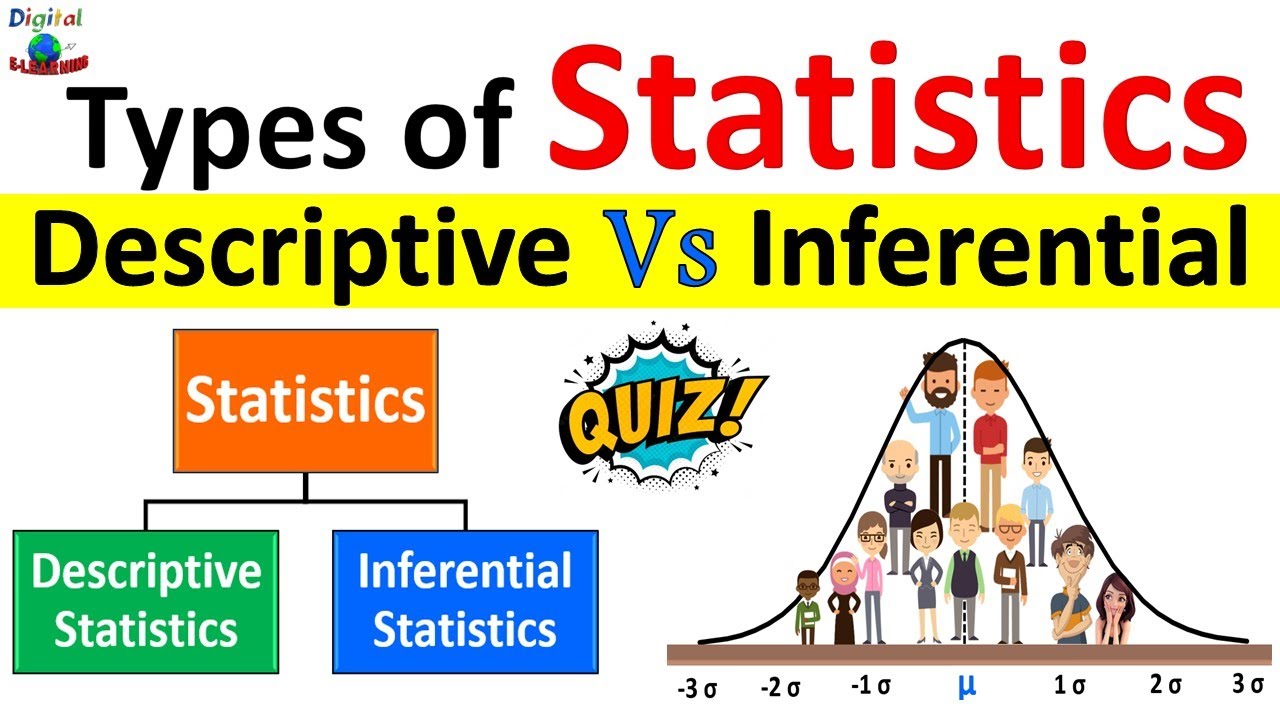Descriptive Statistics [Simply explained]
TLDRThe video script offers a comprehensive introduction to descriptive statistics, explaining its purpose and key components. It emphasizes that descriptive statistics aim to summarize and describe data, highlighting four main components: measures of central tendency (mean, median, mode), measures of dispersion (variance, standard deviation, range, interquartile range), frequency tables, and charts (bar, pie, and others). The script illustrates these concepts with examples, such as analyzing employees' travel methods to work. It also differentiates between descriptive and inferential statistics, noting that the former only describes data without making broader conclusions about a population. The summary underscores the importance of understanding data distribution and central points, and how different statistical tools can provide insights into data characteristics.
Takeaways
- 📊 **Descriptive Statistics Overview**: Descriptive statistics aim to describe and summarize data in a meaningful way, providing an overview of the main characteristics without making conclusions about the population.
- 🔢 **Measures of Central Tendency**: Mean, median, and mode are used to find a central value that represents the entire data set, with the mean being the sum of all observations divided by their number, the median being the middle value in an ordered list, and the mode being the most frequently occurring value(s).
- 📈 **Median's Robustness**: The median is less affected by outliers compared to the mean, making it a robust measure when extreme values are present in the data set.
- 📉 **Measures of Dispersion**: Variance, standard deviation, range, and interquartile range are used to describe how spread out the data is, with standard deviation indicating the average distance from the mean.
- 🧮 **Standard Deviation Calculation**: There are two equations for standard deviation; one for samples (used when surveying a subset of the population) and another for the entire population or when inferring about the population.
- 🔗 **Variance and Standard Deviation**: Variance is the squared standard deviation, providing a measure of how much data points deviate from the mean without considering direction.
- 📊 **Range and Interquartile Range**: The range is the difference between the maximum and minimum values, while the interquartile range represents the middle 50% of the data, offering a measure of data spread.
- 📋 **Frequency and Contingency Tables**: Frequency tables display how often each distinct value appears, while contingency tables (cross tabs) show the relationship between two categorical variables.
- 📊 **Charts for Data Representation**: Bar charts, pie charts, histograms, box plots, violin plots, and rainbow plots are used to visually represent data, with options to display frequencies or percentages and adjust chart types.
- 📐 **Comparing Central Tendency and Dispersion**: Measures of central tendency provide a single value representing the data set, while measures of dispersion indicate how spread out the data points are around the central value.
- 🚗 **Example Application**: The script uses the example of a company surveying employees about their mode of transportation to work, illustrating how descriptive statistics can be applied in a real-world scenario.
Q & A
What is the main purpose of descriptive statistics?
-Descriptive statistics aims to describe and summarize data in a meaningful way, providing a simple overview of the main characteristics of the data without drawing conclusions about the population.
Why can't descriptive statistics be used to make statements about an entire population based on a single company's data?
-Descriptive statistics only describe the collected data without making inferences about the larger population. Just because we know how employees of one company travel to work, we can't generalize this to all employees in a country.
What are the three measures of central tendency?
-The three measures of central tendency are mean, median, and mode. Mean is the sum of all observations divided by the number of observations, median is the middle value in an ordered data set, and mode is the most frequently occurring value(s) in a data set.
How is the median calculated for a data set with an even number of data points?
-For a data set with an even number of data points, the median is calculated by taking the average of the two middle values after the data has been arranged in ascending order.
What is the difference between a unimodal and multimodal data set?
-A unimodal data set has one value that appears most frequently, while a multimodal data set has multiple values that appear most frequently. If a data set has no repeating values or all repeating values have the same frequency, it is considered to have no mode.
What does the standard deviation measure in a data set?
-The standard deviation measures the average distance between each data point and the mean, indicating how much the data points deviate from the mean value on average.
How is the range different from the interquartile range in terms of describing data spread?
-The range is the difference between the minimum and maximum values in a data set, showing the overall spread. The interquartile range represents the middle 50% of the data, showing the spread of the central portion of the data between the first and third quartiles.
What is the role of a frequency table in summarizing data?
-A frequency table displays how often each distinct value appears in a data set, providing a clear and concise summary that makes it easier to understand the distribution of the data.
How does a contingency table differ from a frequency table?
-A contingency table, also known as a cross tab, displays the relationship between two categorical variables by showing the number of observations that fall into each category combination. A frequency table, on the other hand, only displays the frequency of each distinct value for a single variable.
What are some common types of charts used to visualize data?
-Some common types of charts used to visualize data include bar charts, pie charts, histograms, box plots, violin plots, and rainbow plots.
How can a grouped bar chart be useful in data visualization?
-A grouped bar chart is useful in data visualization when comparing the frequencies or percentages of multiple categories across different groups, allowing for an easy comparison of the distribution within each group.
Outlines
📊 Introduction to Descriptive Statistics
This paragraph introduces the topic of descriptive statistics, explaining its purpose and components. Descriptive statistics aim to summarize and describe data in a meaningful way, providing an overview of the main characteristics without making conclusions about the population. The paragraph outlines four key components: measures of central tendency (mean, median, mode), measures of dispersion (variance, standard deviation, range, interquartile range), frequency tables, and charts. It also provides examples of how these measures can be used to analyze data, such as a company surveying its employees' travel methods to work.
📈 Measures of Central Tendency and Dispersion
The second paragraph delves into the specifics of measures of central tendency and dispersion. It explains how the mean, median, and mode represent the central value of a data set and how they are calculated. The paragraph also discusses the resistance of the median to outliers. Measures of dispersion, such as standard deviation, variance, range, and interquartile range, are described as indicators of how spread out the data points are. The standard deviation is highlighted as indicating the average distance from the mean, while the variance is the squared standard deviation. The range and interquartile range are introduced as measures of the data's spread.
📋 Tables and Charts for Data Representation
The final paragraph focuses on the use of tables and charts for representing data. It explains the function of frequency tables and contingency tables (cross tabs) in summarizing categorical data. The paragraph provides an example of how a company might use these tables to understand its employees' transportation preferences. Additionally, it discusses various types of charts, including bar charts, pie charts, histograms, box plots, violin plots, and rainbow plots, and how they can be customized to display frequencies or percentages and to show grouped or stacked data. The paragraph concludes by encouraging viewers to explore these visualization tools further.
Mindmap
Keywords
💡Descriptive Statistics
💡Measure of Central Tendency
💡Median
💡Mode
💡Measure of Dispersion
💡Standard Deviation
💡Variance
💡Range
💡Interquartile Range (IQR)
💡Frequency Table
💡Contingency Table
💡Charts
Highlights
Descriptive statistics is introduced as a method to describe and summarize data in a meaningful way.
Descriptive statistics provides an overview of the main characteristics of data without making conclusions about the population.
Four key components of descriptive statistics are discussed: measures of central tendency, measures of dispersion, frequency tables, and charts.
Mean, median, and mode are explained as measures of central tendency with examples provided.
Median is highlighted as resistant to extreme values or outliers.
Mode is described, including unimodal, bimodal, multimodal, and data sets with no mode.
Measures of dispersion such as variance, standard deviation, range, and interquartile range are introduced to describe the spread of data.
Standard deviation is explained as the average distance between each data point and the mean.
Difference between standard deviation and variance is briefly touched upon, with a reference to a more detailed video.
Range and interquartile range are explained as measures of dispersion, with the interquartile range representing the middle 50% of the data.
Comparison between measures of central tendency and measures of dispersion is made in the context of blood pressure measurements.
Frequency tables are introduced as a way to display how often each distinct value appears in a data set.
Contingency tables, also known as cross tabs, are explained for displaying two categorical variables.
Charts such as bar charts, pie charts, histograms, box plots, violin plots, and rainbow plots are mentioned for visual data representation.
Different chart types are showcased using a sample dataset, including how to adjust settings for frequency or percentage values.
The video concludes with a summary of how descriptive statistics can be applied to understand data and the importance of visual representation.
Transcripts
Browse More Related Video

What is Descriptive Statistics? A Beginner's Guide to Descriptive Statistics!

Descriptive Statistics: FULL Tutorial - Mean, Median, Mode, Variance & SD (With Examples)

Introduction to Descriptive Statistics

Descriptive Statistics vs Inferential Statistics | Measure of Central Tendency | Types of Statistics

Measures of Variability (Range, Standard Deviation, Variance)

Elementary Stats Lesson #3 A
5.0 / 5 (0 votes)
Thanks for rating: